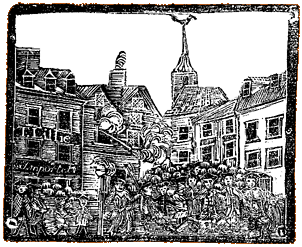“Crying most pitifully all exceeping one”
According to the institute, Hubbard’s “pose, gown, and background were precisely copied from a British engraving of a noblewoman, yet Copley distinguished the work as his own by capturing the figure’s individual features as well as the surfaces and colors of the luxurious fabrics.”
Mary Greene had married Daniel Hubbard (1736–1796) in 1757. Their mothers were first cousins. What’s more, her widowed father had married his widowed mother in 1744. That was one way mercantile families retained their money.
The Hubbards were Loyalists, particularly invested in importing sugar from the slave-labor plantations in Demarara. Daniel Hubbard signed the merchants’ addresses to the last royal governors, and the family remained in town during the siege.
On 18 June 1775, Mary Hubbard wrote this description of the the Battle of Bunker Hill to her half-brother, David Greene (1749–1812):
once more at my Pen I can scarcely compose myself enough for any thing nor will you wonder when you know the situation we are in at presentI don’t know who “Mr. Gore” is, not seeing such a British officer on the list of wounded. Hubbard wrote as if that man had been in the battle and thus not from the civilian family of Gores I’ve studied. (Samuel Gore was arrested after the battle for cracking a joke about the British deaths.)
Yesterday another Battle fought Charlestown the Scene of action they began early in the Morning & continued all day fighting. in the afternoon they set fire to the town & it is now wholy laid in ashes we could view this Melancholy sight from the top of our house
one poor Man went on the top of the meeting house to see the Battle was not able to git down again but perished in the flames.
about five in the afternoon they began to send home their wounded here my dear Brother was a Scene of woe indeed to see such numbers as pass’d by must have moved the hardest heart, judge then the fealings of your Sister, some without Noses some with but one Eye Broken legs & arms some limping along scarcely able to reach the Hospital, while others ware brought in Waggons, Chaise, Coaches, Sedans, & beds on mens Shoulders
the poor Women wringing their hands & crying most pitifully all exceeping one who on seeing her Husband in a cart badly wounded vou’d revenge went of but soon return’d compleatly Equip’t with her gun on her Shoulder her Knapsack at her back march’d down the street & left the poor Husband to try how many she could send along to tell he was comeing.
there is a vast Number of our Men killd & wound a great many Oficers two are sent to their long homes amongst the rest one fine looking Man much about your age who stopt against our windows to have his leg which was sliping moved a little he lived till this morning the poor fellow came a shore but yesterday or the day before, Perhaps his Mothers darling & his Fathers Joy cut of in the midst of his days his Sisters two if he had any must weep his untimely fate
hope it will never be my lot to have any of my near connections follow the Army.
Major [John] Pitcarn & Mr. Gore* both dead with many more that I dont know. we cannot yet learn how many of the enemy are kill’d, think it likely Mr. Hubbard who I supose will give you a particular account of the Battle will be able to write you word, to his Letter I refer you.
* have since heard Mr. Gore is a live
The Hubbards didn’t evacuate Boston with the British military. Daniel kept at his business, and in 1792 was one of the founders of the Union Bank. He died on St. Croix during a voyage back from Demarara in 1796.
Mary Hubbard’s letter was first published by the Charlestown historian Richard Frothingham in 1876 and then as transcribed here in the D.A.R.’s American Monthly Magazine in 1894.
(The correspondent who sent the text to the magazine was Anita Newcomb McGee, a military doctor in the Spanish-American and Russo-Japanese Wars.)











